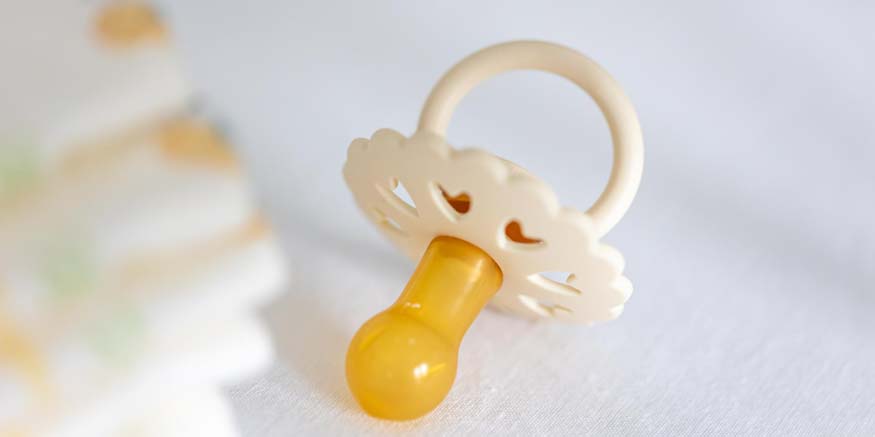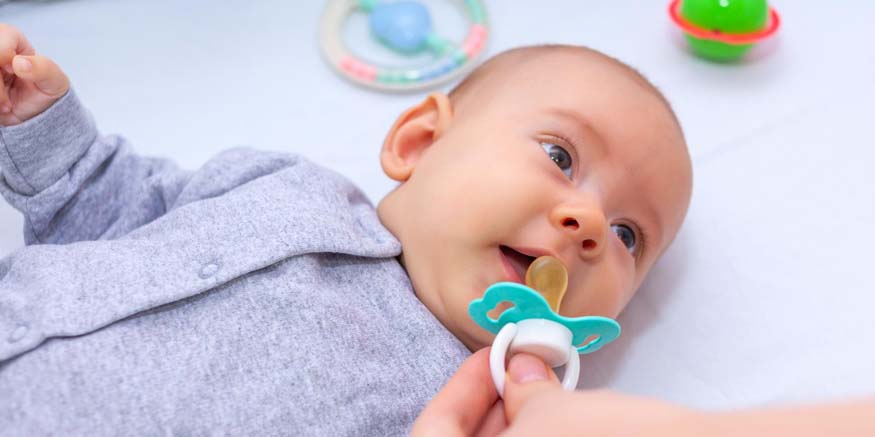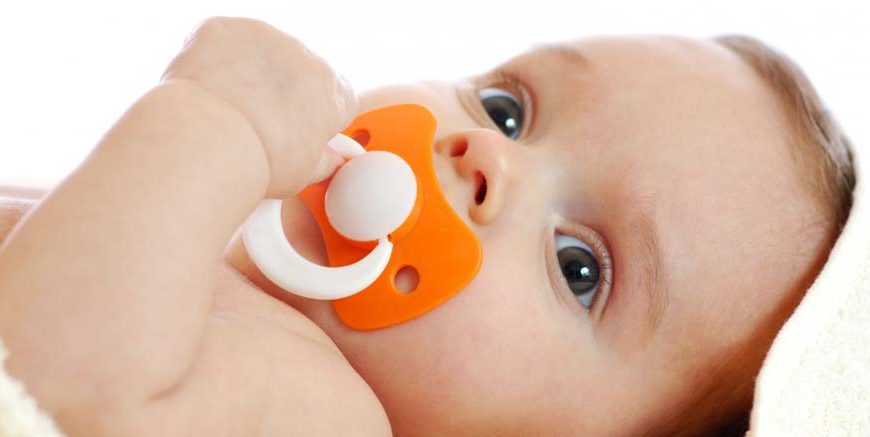Parenthood comes with a whirlwind of decisions, especially when it comes to the well-being and comfort of your newborn. Among these decisions is whether or not to offer a pacifier to your baby. Understanding their potential benefits and safe usage can help you make an informed decision for your little one. So let’s explore the world of pacifiers and how they make your little one’s life a little easier.
What is a Pacifier?
A pacifier, often referred to as a dummy or soother in various parts of the world, is a small, nipple-shaped device designed for infants to suck on. Typically made of silicone, latex or rubber, pacifiers come in various shapes, sizes and designs. They are equipped with a nipple that resembles the shape of a mother’s breast, providing babies with a natural sucking sensation that can offer comfort and relief. When it comes to the question ‘are pacifiers safe for babies?’, it’s crucial to find the right type and size suitable for your baby’s age and development.
Are They Any Good?
You must be wondering, ‘Is a pacifier good for babies?’, especially as a new parent who is trying new ways to support their infant. This is a totally valid concern. While their primary function is to soothe and comfort babies, pacifiers can also contribute to various aspects of infant health and development. Here are some key benefits of using a pacifier for your infant:
- Soothing and Comfort :
- Pain Relief :
- Establishment of Self-Soothing Skills :
- Aid in Weaning from Breast or Bottle :
- Distraction during Travel or Discomfort :
- Promotion of Healthy Sleep Patterns :
One of the most apparent benefits of pacifiers is their ability to provide immediate comfort and relief to infants. The rhythmic sucking action helps babies to self-soothe, easing feelings of distress, agitation or discomfort. This can be particularly helpful during periods of fussiness, teething or when transitioning to sleep.
Pacifiers can serve as a non-pharmacological method of pain relief for infants during minor medical procedures or discomfort associated with conditions such as colic or gas. The sucking action triggers the release of endorphins, natural pain-relieving hormones, providing a soothing effect.
By offering a pacifier, parents can help their infants learn to self-soothe and manage their emotions independently. This skill can be valuable in promoting emotional regulation and resilience as babies grow and develop.
Pacifiers can assist in the weaning process from breastfeeding or bottle-feeding by providing a substitute for sucking comfort. This transition can be particularly beneficial for babies who have difficulty giving up the sucking reflex or for parents who are gradually introducing other feeding methods.
Pacifiers can serve as a helpful distraction during travel, particularly during airplane flights or car rides, by providing babies with a familiar source of comfort and security. Additionally, pacifiers can offer relief during changes in altitude, such as during takeoff and landing, by helping to equalize pressure in the ears.
Pacifiers may aid in establishing healthy sleep habits by assisting babies in self-soothing and falling asleep independently. When used appropriately, pacifiers can be part of a bedtime routine that signals to infants that it’s time to relax and prepare for sleep.
When is a Good Time to Introduce a Pacifier?

When to give a newborn pacifier is an important concern to discuss. Timing is crucial when it comes to introducing a pacifier to your infant. Here are some key points to consider:
- Wait Until Breastfeeding is Established :
- Avoid Introducing Too Early :
- Observe Baby’s Cues :
- Consider Individual Readiness:
- Monitor for Signs of Readiness :
Healthcare professionals generally recommend waiting until breastfeeding is well-established, typically around three to four weeks after birth, before introducing a pacifier. This allows infants to develop a strong breastfeeding relationship with their mother without the risk of nipple confusion.
Introducing a pacifier too early, particularly within the first few days of life, may lead to nipple confusion and difficulties with latching during breastfeeding sessions. Waiting until breastfeeding is established reduces the likelihood of confusion between the pacifier and the breast.
Pay attention to your baby’s cues for comfort and readiness for a pacifier. Some infants may display signs of seeking non-nutritive sucking, such as sucking on their fingers or hands. Introducing a pacifier at this stage can provide a safe and soothing alternative.
Every baby is different, so the timing of introducing a pacifier may vary. Consider your baby’s individual needs and developmental readiness when deciding when to introduce a pacifier. Consulting with healthcare professionals can provide valuable guidance in this regard.
Look for signs that your baby is ready for a pacifier, such as increased sucking reflex, comfort-seeking behaviors or difficulty soothing without non-nutritive sucking. Introducing a pacifier when your baby displays these signs can help ensure acceptance and effectiveness.
How to Use a Pacifier for Your Baby

Using a pacifier effectively involves more than just popping it into your baby’s mouth. Here are some important tips for how to use pacifier for baby safely and appropriately:
- Choose the Right Pacifier:
- Sterilize Before Use :
- Limit Use :
- Establish a Routine:
- Monitor for Signs of Dependency :
- Keep Pacifiers Clean :
- Be Mindful of Safety:
Select a pacifier that is specifically designed for your baby’s age and development. Look for pacifiers made of safe materials, such as silicone or latex, and ensure they are BPA-free. Opt for pacifiers with ventilation holes to reduce the risk of choking.
Before using a pacifier for the first time, sterilize it by boiling it in water for a few minutes or using a sterilizer designed for baby products. This helps eliminate any bacteria or contaminants that may be present.
While pacifiers can provide comfort and soothing benefits, it’s important to use them in moderation. Avoid excessive reliance on pacifiers, especially for prolonged periods, as this can interfere with feeding and speech development. Reserve pacifiers for soothing moments or bedtime.
Introduce a pacifier as part of a consistent bedtime or soothing routine. This helps signal to your baby that it’s time to relax and prepare for sleep. Avoid using pacifiers as a substitute for feeding or as a means of delaying feedings.
Pay attention to your baby’s reliance on pacifiers and monitor for signs of dependency. While pacifiers can provide comfort, excessive use may lead to difficulties with self-soothing and can interfere with breastfeeding. Encourage gradual weaning from pacifiers as your baby grows.
Clean pacifiers regularly with warm, soapy water and rinse thoroughly. Inspect pacifiers for signs of wear or damage, and replace them as needed to maintain safety and hygiene. Avoid sharing pacifiers between multiple babies to prevent the spread of germs.
Always supervise your baby when using a pacifier, especially during sleep. Avoid attaching pacifiers to cords, ribbons, or clips that could pose a strangulation hazard. Ensure pacifiers are securely attached to pacifier clips or holders to prevent choking.
Offering a pacifier to your baby can be a beneficial tool for soothing and comforting them, but it’s essential to prioritize safety and moderation. By understanding the benefits, appropriate usage and timing of introducing pacifiers, you can make an informed decision that supports your baby’s well-being and development. As with any parenting choice, trust your instincts and consult with healthcare professionals for personalized guidance.
For more information, visit EuroKids.
















